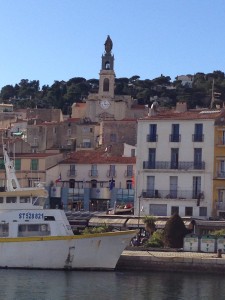I must first have noticed the city of Sete on the map, where the Languedoc region of southern France creeps down to the edge of the Mediterranean Sea.
Sete is near the southern end of a confused stretch of French coastline, where land gives way to water and back again from west of Marseille almost to Narbonne.
Sete is possible because of a 400-foot hill that juts out of the sea, with a huge bay on one side and the Mediterranean on the other, allowing the population of 42,000 or so to cluster on the mountain’s slopes and take its living from the water below.
Sete was to come up again in Abu Dhabi, when The National was referring to an interesting midfielder/forward named Gregory Dufrennes, who scored lots of goals for two second-tier teams, Dubai Club and Ittihad Kalba.
Dufrennes is French, and his previous professional stop, before making the leap over to the UAE, was FC Sete 34 — which wikipedia later informed me was twice champion of France. Which is astonishing, considering how small the city is.
And we drove over there today to have a look around and to try to get a sense of a city that must be the smallest to win a French top-flight soccer championship, let alone two of them.
France did not get around to having a national soccer competition until 1932-33, long after England and Scotland and Germany and Spain and Italy were well under way.
Why should that be? I believe it is because of the difficulty of getting around France back then — before commercial aviation was significant, before fast trains linked most of the bigger cities. It perhaps is telling that the 14- or 16-team league, back then, had two poles — clusters of clubs near the border of Belgium and near the English Channel, and a smaller cluster in the south, around Nimes, Montpellier and, yes, Sete.
Sete apparently was able to compete in a professional league, despite its small size, because it early on embraced the idea of foreign players. The authors of The Global Sports Arena, which focuses on the movement of soccer players around the world, posits that France never developed a nationalistic sense of “our football†(unlike most countries that became enamored of the game) and thus was taking in foreign-born players from the start.
Sete certainly was near the top of the list: The book suggests that half of all of Sete’s players through 1960 were foreign-born.
The club’s best two players in their inter-war decade of hanging out with the elite were Ivan Beck, an ethnic German born in Belgrade, and Desire Koranyi, a Hungarian. Both were attacking players.
The 6-foot-5 Beck was the leader of the Sete teams that won the 1934 national championship, as well as the French Cup in 1930 and 1934. (In the latter year, Sete became the first French club to win a double — cup and league, an accomplishment that prompted team management to rename the team FC Sete 34.)
Koranyi was key in the 1939 championship, scoring a league-best 27 goals as Sete finished two points clear of Olympic Marseille in a table that included many names still prominent in France now.
That was the last “real†French championship until 1946. In September of 1939, France mobilized its army after Germany invaded Poland, and most clubs stopped playing.
It seems almost incomprehensible, now, that football would halt for long stretches, but the world wars accomplished it. Granted, some French teams continued to play, with children or old men, through the invasion of France and the subsequent five years of German occupation.
Sete plays on, too. The club remained relevant on the national scene until 1960, when the club collapsed financially and was reduced to amateur status, returning as a professional side in 2005-06, the second season in Sete for our future UAE expatriate, Gregory Dufrennes.
FC Sete 34 remains a small club, and has not risen above Ligue 2 since its return to professional status. It plays in a stadium of 8,700 capacity, located on the northern side of the city — but right next to the original Sete stadium, Stade Georges Bayrou, the site of the 1930s successes and now a practice ground.
The city of Sete, girdling Mont St. Clair, appears to be oriented towards maritime activity — ferries run to Morocco and Algeria — as well as tourism. It is at the northeast end of a nine-mile narrow strip of land that separates the Bassin du Thau from the Mediterranean and is perfectly placed to host thousands of summer visitors, some of whom probably would like to visit the “Pirateland†amusement park.
We walked about the city center and had falafel sandwiches, and noted the kebab shops: The city appears to have a significant North African population.
Like several other past-their-prime water-oriented resorts (think Catalina Island, off the coast of Southern California) the town is a bit tatty. The downtown underground parking garage looks as if it might collapse at any moment, and the city center looks its age.
It seems unlikely more French football championships are on the way. Returning to Ligue 1 at all would be a huge accomplishment.
In the meantime, Sete has its history, as well as the graves of immigrant stars Beck and Koranyi. The former became a Sete dockworker (guys did that after soccer, back in the 1950s) and the latter, club record-holder for goals (156, sixth in French history) and appearances, returned as a coach and has a street named in his honor.


0 responses so far ↓
There are no comments yet...Kick things off by filling out the form below.
Leave a Comment